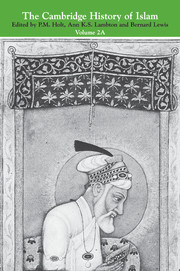Book contents
- Frontmatter
- Introduction
- Part V The Indian sub-continent
- 1 MUSLIM INDIA BEFORE THE MUGHALS
- 2 INDIA UNDER THE MUGHALS
- APPENDIX THE SULTANATES OF THE DECCAN, SIXTEENTH TO EIGHTEENTH CENTURIES
- 3 THE BREAKDOWN OF TRADITIONAL SOCIETY
- 4 INDIA AND PAKISTAN
- Part VI SOUTH-EAST ASIA
- Part VII AFRICA AND THE MUSLIM WEST
- Bibliography
- References
3 - THE BREAKDOWN OF TRADITIONAL SOCIETY
from Part V - The Indian sub-continent
Published online by Cambridge University Press: 28 March 2008
- Frontmatter
- Introduction
- Part V The Indian sub-continent
- 1 MUSLIM INDIA BEFORE THE MUGHALS
- 2 INDIA UNDER THE MUGHALS
- APPENDIX THE SULTANATES OF THE DECCAN, SIXTEENTH TO EIGHTEENTH CENTURIES
- 3 THE BREAKDOWN OF TRADITIONAL SOCIETY
- 4 INDIA AND PAKISTAN
- Part VI SOUTH-EAST ASIA
- Part VII AFRICA AND THE MUSLIM WEST
- Bibliography
- References
Summary
By the beginning of the eighteenth century, Muslim society in India was composed of descendants of Turkic, Afghan, Persian and Arab immigrants, and of Indian Muslims who had embraced Islam in different regions and circumstances, and under varied pressures. The immigrants, who themselves belonged to distinct culture groups, brought with them the characteristic features of their ethnic and non-Islamic religious backgrounds. In the course of time, the interaction of their various ideas and values contributed to the rise of cultural traditions which were radically different from those of their birthplaces; Muslims, while retaining the broad basic framework of their religion, evolved healthy traditions of toleration, and of peaceful coexistence with the indigenous population. A great deal of similarity developed in the dress and ornaments of Hindus and Muslims. Though the eating habits of the members of the two religious groups differed in important respects, especially in the eating of meat, these difficulties did not undermine their social relations. They appreciated each other's religions and social taboos and adjusted their lives in an atmosphere of social amity and mutual understanding. Hindu and Muslim peasants, artisans, craftsmen and merchants worked in close co-operation with each other. Hindu bankers, merchants and money-lenders controlled trade and commerce and exercised considerable influence over the finances of the government. They were the backbone of society.
The use of Persian served as a strong unifying bond between the Hindu and Muslim upper classes. Translations of some Hindu religious works into Persian widened the outlook of those Hindus who were linked with the Mughal administrative machinery; and an atmosphere of sympathetic understanding of the spiritual problems of the two major religions of India was thus created.
- Type
- Chapter
- Information
- The Cambridge History of Islam , pp. 67 - 96Publisher: Cambridge University PressPrint publication year: 1977
References
- 2
- Cited by



